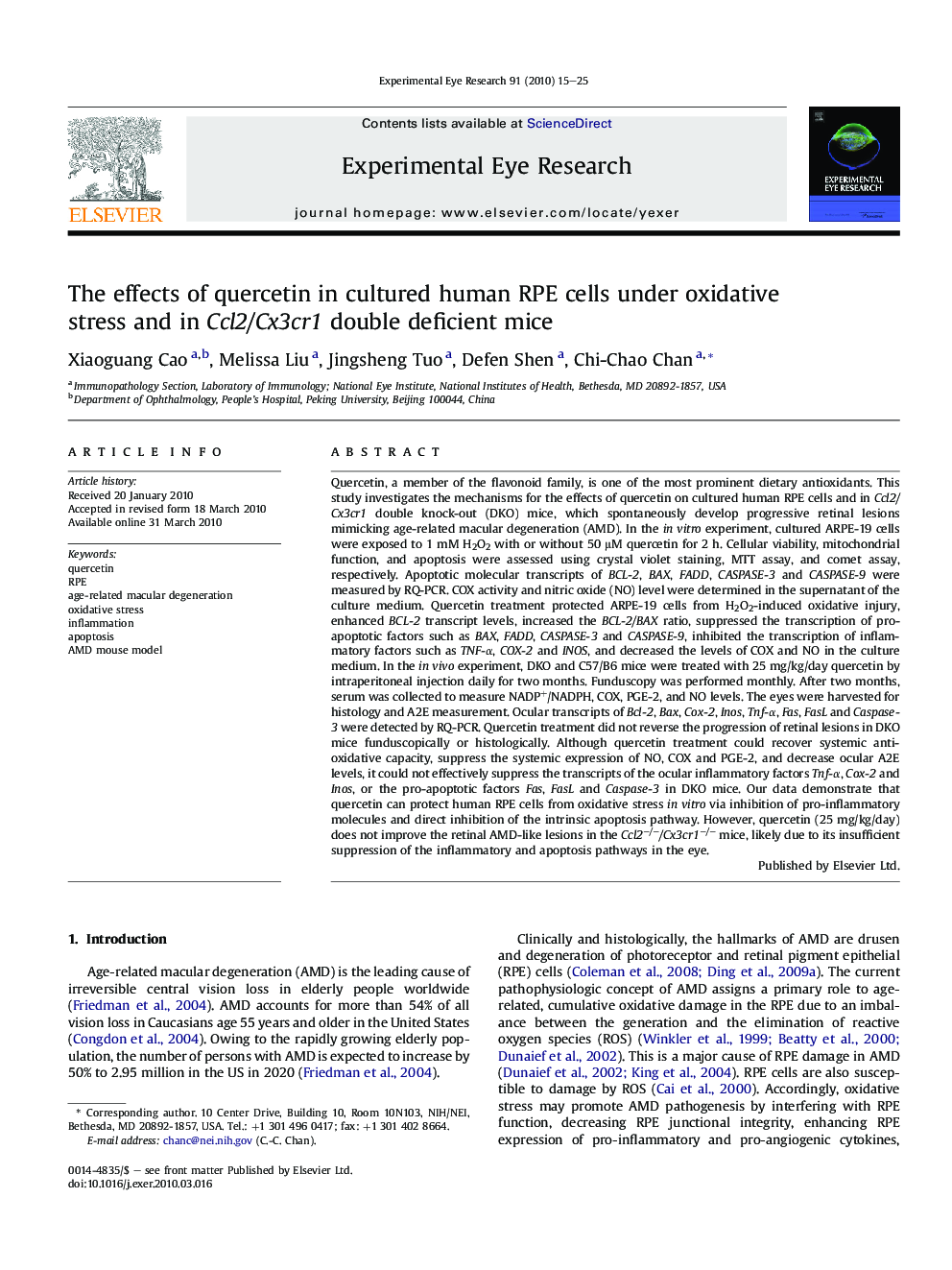| کد مقاله | کد نشریه | سال انتشار | مقاله انگلیسی | نسخه تمام متن |
|---|---|---|---|---|
| 4011797 | 1261165 | 2010 | 11 صفحه PDF | دانلود رایگان |

Quercetin, a member of the flavonoid family, is one of the most prominent dietary antioxidants. This study investigates the mechanisms for the effects of quercetin on cultured human RPE cells and in Ccl2/Cx3cr1 double knock-out (DKO) mice, which spontaneously develop progressive retinal lesions mimicking age-related macular degeneration (AMD). In the in vitro experiment, cultured ARPE-19 cells were exposed to 1 mM H2O2 with or without 50 μM quercetin for 2 h. Cellular viability, mitochondrial function, and apoptosis were assessed using crystal violet staining, MTT assay, and comet assay, respectively. Apoptotic molecular transcripts of BCL-2, BAX, FADD, CASPASE-3 and CASPASE-9 were measured by RQ-PCR. COX activity and nitric oxide (NO) level were determined in the supernatant of the culture medium. Quercetin treatment protected ARPE-19 cells from H2O2-induced oxidative injury, enhanced BCL-2 transcript levels, increased the BCL-2/BAX ratio, suppressed the transcription of pro-apoptotic factors such as BAX, FADD, CASPASE-3 and CASPASE-9, inhibited the transcription of inflammatory factors such as TNF-α, COX-2 and INOS, and decreased the levels of COX and NO in the culture medium. In the in vivo experiment, DKO and C57/B6 mice were treated with 25 mg/kg/day quercetin by intraperitoneal injection daily for two months. Funduscopy was performed monthly. After two months, serum was collected to measure NADP+/NADPH, COX, PGE-2, and NO levels. The eyes were harvested for histology and A2E measurement. Ocular transcripts of Bcl-2, Bax, Cox-2, Inos, Tnf-α, Fas, FasL and Caspase-3 were detected by RQ-PCR. Quercetin treatment did not reverse the progression of retinal lesions in DKO mice funduscopically or histologically. Although quercetin treatment could recover systemic anti-oxidative capacity, suppress the systemic expression of NO, COX and PGE-2, and decrease ocular A2E levels, it could not effectively suppress the transcripts of the ocular inflammatory factors Tnf-α, Cox-2 and Inos, or the pro-apoptotic factors Fas, FasL and Caspase-3 in DKO mice. Our data demonstrate that quercetin can protect human RPE cells from oxidative stress in vitro via inhibition of pro-inflammatory molecules and direct inhibition of the intrinsic apoptosis pathway. However, quercetin (25 mg/kg/day) does not improve the retinal AMD-like lesions in the Ccl2−/−/Cx3cr1−/− mice, likely due to its insufficient suppression of the inflammatory and apoptosis pathways in the eye.
Journal: Experimental Eye Research - Volume 91, Issue 1, July 2010, Pages 15–25